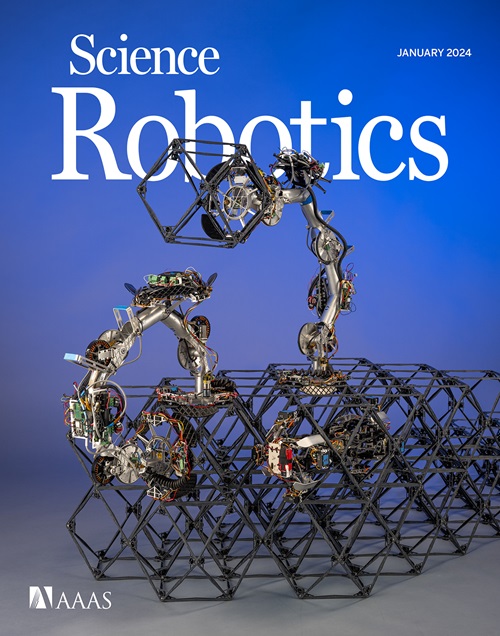A compact neuromorphic system for ultra–energy-efficient, on-device robot localization
IF 27.5
1区 计算机科学
Q1 ROBOTICS
引用次数: 0
Abstract
Neuromorphic computing offers a transformative pathway to overcome the computational and energy challenges faced in deploying robotic localization and navigation systems at the edge. Visual place recognition, a critical component for navigation, is often hampered by the high resource demands of conventional systems, making them unsuitable for small-scale robotic platforms, which still require accurate long-endurance localization. Although neuromorphic approaches offer potential for greater efficiency, real-time edge deployment remains constrained by the complexity of biorealistic networks. To overcome this challenge, fusion of hardware and algorithms is critical when using this specialized computing paradigm. Here, we demonstrate a neuromorphic localization system that performs competitive place recognition in up to 8 kilometers of traversal using models as small as 180 kilobytes with 44,000 parameters while consuming less than 8% of the energy required by conventional methods. Our system, locational encoding with neuromorphic systems (LENS), integrates spiking neural networks, an event-based dynamic vision sensor, and a neuromorphic processor within a single SynSense Speck chip, enabling real-time, energy-efficient localization on a hexapod robot. When compared with a benchmark place recognition method, sum of absolute differences, LENS performs comparably in overall precision. LENS represents an accurate fully neuromorphic localization system capable of large-scale, on-device deployment for energy-efficient robotic place recognition. Neuromorphic computing enables resource-constrained robots to perform energy-efficient, accurate localization.
一个紧凑的神经形态系统,用于超节能,设备上的机器人定位
神经形态计算为克服在边缘部署机器人定位和导航系统所面临的计算和能源挑战提供了一种变革性的途径。视觉位置识别是导航的关键组成部分,但传统系统对资源的高需求往往阻碍了视觉位置识别,使其不适合小型机器人平台,因为这些平台仍然需要精确的长时间定位。尽管神经形态方法提供了更高效率的潜力,但实时边缘部署仍然受到生物现实网络复杂性的限制。为了克服这一挑战,在使用这种专门的计算范式时,硬件和算法的融合至关重要。在这里,我们展示了一个神经形态定位系统,该系统使用小至180kb的模型和44,000个参数,在长达8公里的穿越中执行竞争性位置识别,而消耗的能量不到传统方法所需能量的8%。我们的系统,定位编码与神经形态系统(LENS),集成了脉冲神经网络,一个基于事件的动态视觉传感器,和一个神经形态处理器在一个单一的SynSense Speck芯片,实现实时,高效的定位六足机器人。与基准位置识别方法(绝对差值和)相比,LENS在整体精度上具有相当的优势。LENS代表了一种精确的全神经形态定位系统,能够大规模,在设备上部署节能机器人位置识别。神经形态计算使资源受限的机器人能够执行节能、准确的定位。
本文章由计算机程序翻译,如有差异,请以英文原文为准。
求助全文
约1分钟内获得全文
求助全文
来源期刊

Science Robotics
Mathematics-Control and Optimization
CiteScore
30.60
自引率
2.80%
发文量
83
期刊介绍:
Science Robotics publishes original, peer-reviewed, science- or engineering-based research articles that advance the field of robotics. The journal also features editor-commissioned Reviews. An international team of academic editors holds Science Robotics articles to the same high-quality standard that is the hallmark of the Science family of journals.
Sub-topics include: actuators, advanced materials, artificial Intelligence, autonomous vehicles, bio-inspired design, exoskeletons, fabrication, field robotics, human-robot interaction, humanoids, industrial robotics, kinematics, machine learning, material science, medical technology, motion planning and control, micro- and nano-robotics, multi-robot control, sensors, service robotics, social and ethical issues, soft robotics, and space, planetary and undersea exploration.
 求助内容:
求助内容: 应助结果提醒方式:
应助结果提醒方式:


